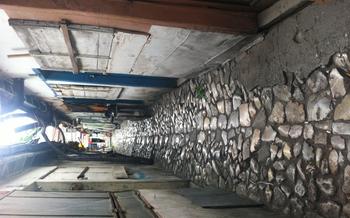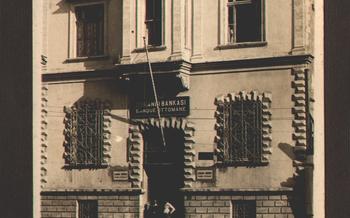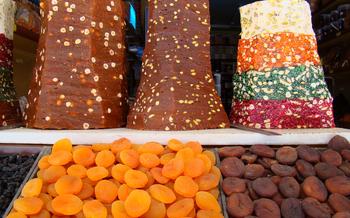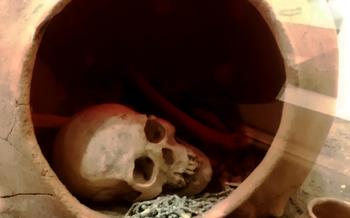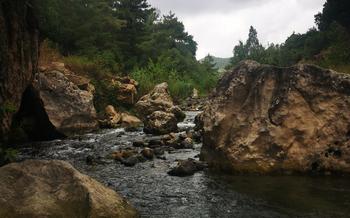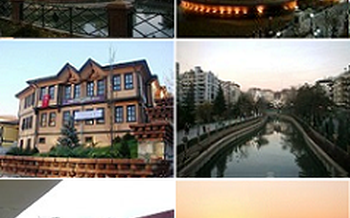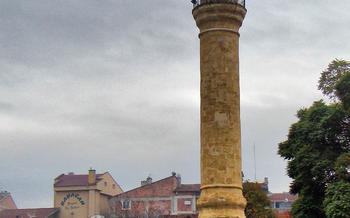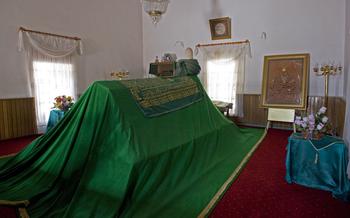
Ulu Mosque a prominent religious site in Çorum
- Unveiling Çorum's Spiritual Jewel: Ulu Mosque
- A Journey Through Time: History of the Ulu Mosque
- A Masterpiece of Islamic Architecture
- A Place of Worship and Community
- Symbol of Çorum's Cultural Heritage
- Experiencing the Ulu Mosque: Practical Tips
- Unveiling the Hidden Gems: Exploring the Mosque's Interior
- A Walk Through History: Exploring the Mosque's Surroundings
- Beyond the Mosque: Exploring Çorum's Treasures
- The People of Çorum: Warmth and Hospitality
- Capturing the Essence: Photography Tips
- A Journey Through Time: History of Çorum
- Beyond the Ulu Mosque: Exploring Çorum's Religious Sites
- Preserving the Legacy: Conservation Efforts
- Insider Tip: Unveiling Hidden Treasures
Unveiling Çorum's Spiritual Jewel: Ulu Mosque
In the heart of Çorum, a city steeped in history and culture, stands the Ulu Mosque, a testament to the region's rich Islamic heritage. Erected during the Seljuk era, this architectural masterpiece has served as a beacon of spirituality and a symbol of religious devotion for centuries. Its grand presence dominates the city's skyline, beckoning visitors and locals alike to explore its sacred halls and discover the profound impact it has had on Çorum's cultural tapestry.
The Ulu Mosque's history is intertwined with the rise and fall of civilizations, reflecting the region's diverse past. Originally constructed in the 13th century, the mosque has undergone several renovations and expansions over the years, each adding a unique layer to its architectural narrative. The mosque's enduring legacy as a prominent religious site is a testament to its enduring significance in the lives of Çorum's inhabitants.
As a cultural landmark, the Ulu Mosque holds immense value. Its intricate carvings, tile work, and elegant domes exemplify the finest craftsmanship of the Seljuk era. The mosque's harmonious blend of architectural styles, from Seljuk to Ottoman, showcases the evolution of Islamic architecture in Anatolia. This fusion of influences has shaped the Ulu Mosque into a unique and awe-inspiring masterpiece, capturing the essence of Çorum's rich cultural heritage.
A Journey Through Time: History of the Ulu Mosque
The Ulu Mosque stands as a testament to Çorum's rich history, with its origins dating back to the Seljuk era. Built during the reign of Sultan Mesud I, the mosque's construction began in 1147 and was completed in 115The mosque underwent several renovations and additions over the centuries, reflecting the architectural influences of different periods. In the 13th century, the mosque was expanded during the reign of Sultan Alaeddin Keykubad I, who added a new section to the prayer hall and renovated the courtyard. The mosque's minarets were added during the Ottoman period, further enhancing its architectural grandeur.
Despite the passage of time, the Ulu Mosque has undergone extensive restoration efforts to preserve its historical integrity. In the 19th century, the mosque was extensively renovated under the supervision of the Ottoman architect, Ali Rıza Bey. These renovations included the repair of the mosque's roof, the restoration of its tile work, and the addition of new decorative elements. The mosque's current appearance is largely the result of these 19th-century renovations, which have ensured its preservation for future generations.
A Masterpiece of Islamic Architecture
The Ulu Mosque stands as a testament to Islamic architectural brilliance, showcasing a harmonious blend of Seljuk and Ottoman influences. Its exterior facade captivates with intricate carvings and tile work, creating a stunning visual spectacle. Inside, the mosque's spacious prayer hall exudes an atmosphere of serenity and devotion, adorned with elegant decorations and mesmerizing patterns. Towering minarets and graceful domes pierce the skyline, adding to the mosque's grandeur and serving as beacons of faith. The serene courtyard and ablutions area provide a tranquil space for contemplation and purification before entering the sacred prayer hall. Every element of the Ulu Mosque's architecture comes together in a symphony of beauty and spirituality, reflecting the deep-rooted Islamic traditions and artistic prowess of Çorum.
A Place of Worship and Community
The Ulu Mosque serves not only as a place of worship but also as a vibrant community center for the people of Çorum. Its significance extends beyond its religious function, as it hosts a range of community events and gatherings that foster social cohesion and a sense of belonging.
During daily prayers, the mosque comes alive with the faithful gathering to perform their religious obligations. The atmosphere is one of reverence and devotion, as worshippers unite in prayer and seek spiritual guidance. The mosque also plays a crucial role during religious festivals and celebrations, such as Ramadan and Eid, when it becomes the focal point of community festivities and celebrations.
In addition to its religious and social functions, the Ulu Mosque serves as an educational center for Islamic studies and learning. It offers classes and lectures on various aspects of Islam, providing opportunities for people to deepen their understanding of their faith and traditions. These educational initiatives contribute to the preservation and transmission of Islamic knowledge within the community.
The Ulu Mosque's multifaceted role as a place of worship, community center, and educational institution reflects its deep integration into the fabric of Çorum society. It is a place where people come together to pray, celebrate, learn, and connect with one another, strengthening the bonds of community and fostering a sense of shared identity.
Symbol of Çorum's Cultural Heritage
The Ulu Mosque stands not only as a religious landmark but also as a symbol of Çorum's rich cultural heritage. It embodies the city's unique traditions and customs, showcasing the deep-rooted history and identity of the region.
Storytelling and legends surrounding the mosque have been passed down through generations, adding an enchanting aura to its significance. Locals share fascinating tales that intertwine with the mosque's history, creating a captivating narrative that brings the past to life.
The Ulu Mosque's architectural style, intricate carvings, and stunning decorations are expressions of Çorum's artistic heritage. This masterpiece of Islamic architecture reflects the city's appreciation for beauty, craftsmanship, and artistic expression.
Beyond its physical presence, the mosque serves as a symbol of Çorum's cultural identity. It represents the city's strong connection to its Islamic roots and its commitment to preserving its cultural heritage for future generations. The Ulu Mosque stands as a testament to Çorum's enduring spirit and its pride in its unique cultural identity.
Experiencing the Ulu Mosque: Practical Tips
Visiting Hours: The Ulu Mosque is generally open to visitors during daylight hours, but it's advisable to check with local authorities or the mosque's administration for specific visiting hours. Some mosques may have designated prayer times when visitors are restricted from entering.
Dress Code: As a sign of respect, visitors are expected to dress modestly when visiting the mosque. This includes covering shoulders, knees, and avoiding revealing clothing. Women may be required to cover their heads with a headscarf or shawl.
Respectful Behavior: The Ulu Mosque is an active place of worship, and visitors should be mindful of their behavior. This includes maintaining silence, avoiding loud conversations, and not disturbing worshippers. Photography is usually allowed, but it's essential to be discreet and respectful of those praying.
Photography Guidelines: Photography is generally permitted within the Ulu Mosque, but it's essential to follow the guidelines set by the mosque's administration. Some areas may be restricted from photography, and it's essential to respect these restrictions. Using flash photography is often discouraged to avoid disturbing worshippers or damaging the mosque's interior.
Unveiling the Hidden Gems: Exploring the Mosque's Interior
Step inside the Ulu Mosque, and prepare to be captivated by its exquisite interior. Admire the intricate details of the mihrab, the prayer niche that indicates the direction of Mecca, adorned with stunning calligraphy and tile work. Discover the significance of the minbar, the pulpit from which the imam delivers sermons, often featuring intricate carvings and designs. Gaze upon the beautiful calligraphy and inscriptions that adorn the mosque's walls, showcasing verses from the Quran and other religious texts. Marvel at the colorful stained glass windows that filter light into the mosque's interior, creating a mesmerizing play of colors. Understand the significance of the qibla wall, which indicates the direction of Mecca and serves as a focal point for prayers.
A Walk Through History: Exploring the Mosque's Surroundings
Venturing beyond the Ulu Mosque's sacred walls, you'll find yourself immersed in Çorum's rich history and vibrant culture. A short stroll from the mosque, you'll encounter an array of historical sites and landmarks that complement your visit. Explore the ancient ruins of Çorum Kalesi, a formidable fortress that once guarded the city. Marvel at the intricate stonework and impressive architecture of the Bedesten, a historical market building that now houses an array of shops and boutiques.
For a glimpse into Çorum's vibrant daily life, delve into the bustling local markets. Here, you'll find an assortment of fresh produce, traditional handicrafts, and local delicacies. Engage with the friendly vendors and immerse yourself in the vibrant atmosphere of these bustling marketplaces.
When hunger strikes, tantalize your taste buds with Çorum's delectable cuisine. Indulge in mouthwatering dishes such as keşkek, a hearty wheat and meat stew, or mantı, delicious dumplings served with yogurt sauce. Numerous restaurants near the mosque offer a culinary journey that will delight your palate and leave you craving more.
After a day of exploration, find respite in one of the comfortable accommodation options near the mosque. Whether you prefer the cozy ambiance of a traditional guesthouse or the modern amenities of a hotel, you'll find a range of options to suit your preferences and budget.
Beyond the Mosque: Exploring Çorum's Treasures
Venture beyond the Ulu Mosque and uncover the hidden treasures that Çorum holds. Immerse yourself in the city's rich history and cultural heritage by visiting its museums, which house fascinating artifacts and exhibits that tell the story of Çorum's past. Discover the stunning natural wonders that surround the city, from scenic valleys and cascading waterfalls to lush forests teeming with diverse flora and fauna. Embrace the great outdoors and indulge in activities such as hiking, biking, and picnicking amidst Çorum's breathtaking landscapes. Experience the vibrant energy of the city's festivals and events, which showcase local traditions, music, dance, and cuisine, providing a glimpse into the heart and soul of Çorum's culture.
The People of Çorum: Warmth and Hospitality
Çorum's people are renowned for their warm hospitality and welcoming nature. Engaging with the locals is a fantastic way to immerse yourself in the city's culture and gain a deeper understanding of its traditions. Don't hesitate to strike up conversations with shopkeepers, restaurant owners, or fellow travelers. You'll find that the people of Çorum are genuinely interested in sharing their stories and experiences with visitors.
One of the best ways to experience Çorum's hospitality is to participate in a cultural exchange. There are several opportunities to do this, such as attending cooking classes, traditional dance lessons, or language exchange meetups. These activities allow you to connect with locals on a personal level and learn about their daily lives.
If you're interested in learning more about Çorum's history and culture, consider hiring a local guide. Local guides can provide you with valuable insights and take you to hidden gems that you might not find on your own. They can also help you overcome language barriers and ensure that you have a safe and enjoyable experience.
Remember to be respectful of local customs and traditions when interacting with the people of Çorum. Dress modestly, avoid discussing sensitive topics, and always ask permission before taking someone's photo. By showing respect and curiosity, you'll be sure to make a positive impression and leave Çorum with fond memories of the people you met.
Capturing the Essence: Photography Tips
The Ulu Mosque's architectural grandeur and intricate details are a photographer's dream. To capture the mosque's essence through your lens, here are some tips:
-
Best Angles: Explore the mosque's exterior to find the best angles that showcase its majestic facade, minarets, and domes. The courtyard offers unique perspectives, allowing you to capture the mosque's symmetry and scale.
-
Lighting Conditions: Visit the mosque at different times of day to witness the changing natural light. The soft, warm light of dawn and dusk can create dramatic shadows and enhance the mosque's textures.
-
Composition Techniques: Use leading lines, such as the arches and columns, to draw the viewer's eye towards the mosque's focal points. Incorporate elements of the surrounding environment, such as trees or the city skyline, to create depth and context.
-
Editing and Post-Processing: After capturing your shots, take advantage of editing software to enhance their impact. Adjust the colors, contrast, and exposure to create a cohesive and visually appealing series of photographs.
A Journey Through Time: History of Çorum
Çorum's history is a rich tapestry woven from the threads of ancient civilizations, powerful empires, and modern developments. In ancient times, the Hittites, Phrygians, and Romans left their mark on the region, shaping its cultural and historical landscape. During the Seljuk era, Çorum flourished as an important center of trade and learning, with the construction of magnificent mosques, madrasahs, and caravanserais. The Ottoman Empire further solidified Çorum's status as a regional hub, leaving behind a legacy of architectural wonders, including the iconic Ulu Mosque.
In the modern era, Çorum has undergone a remarkable transformation, emerging as a vibrant city that harmoniously blends its rich history with contemporary progress. Visitors to Çorum can embark on a journey through time, exploring ancient ruins, marveling at Seljuk and Ottoman masterpieces, and experiencing the city's modern dynamism. Çorum's historical landmarks, such as the Hatuniye Madrasah and the Çorum Museum, offer valuable insights into the city's storied past, while its modern attractions, including shopping malls, parks, and cultural centers, showcase its embrace of progress.
Beyond the Ulu Mosque: Exploring Çorum's Religious Sites
While the Ulu Mosque stands as the most prominent religious site in Çorum, the city is home to a diverse array of other sacred spaces that offer unique insights into its rich religious heritage. For those seeking to delve deeper into Çorum's spiritual tapestry, embarking on a journey to explore its lesser-known religious sites is a rewarding endeavor.
Among the notable mosques in Çorum is the Alaca Mosque, renowned for its striking blue tiles and intricate carvings. The Hacı Bektaş Veli Mosque holds a special place in the hearts of locals, as it is believed to have been built on the site where the renowned Sufi saint once resided. Visitors can also explore the Arslanbey Mosque, which boasts a unique blend of Seljuk and Ottoman architectural styles.
For those interested in Christian heritage, Çorum offers several churches and monasteries that showcase the city's diverse religious history. The Surp Krikor Lusavoric Armenian Church is a particularly significant site, as it is one of the few remaining Armenian churches in the region. The Kızıl Kilise (Red Church), located in the picturesque village of Kızılcaören, is another must-see destination for its well-preserved frescoes and stunning views of the surrounding countryside.
To fully immerse oneself in Çorum's religious atmosphere, it is essential to experience the city's vibrant religious festivals. The Hıdırellez Festival, celebrated in May, is a joyful celebration of spring that brings together people from all backgrounds. The Mevlid-i Nebi festival, commemorating the birth of the Prophet Muhammad, is another significant event that showcases Çorum's Islamic traditions.
For those seeking a deeper understanding of interfaith dialogue, Çorum offers opportunities to engage with people of different faiths. The Çorum Interfaith Dialogue Center organizes regular events and workshops that promote understanding and cooperation among different religious communities. Visitors can participate in these events to learn about the diverse beliefs and practices that coexist harmoniously in Çorum.
Preserving the Legacy: Conservation Efforts
The Ulu Mosque's enduring legacy is meticulously safeguarded through ongoing conservation endeavors. These efforts prioritize preserving the mosque's architectural integrity and historical authenticity. Skilled artisans, utilizing traditional techniques, meticulously restore intricate details and ornamentation, ensuring the mosque's grandeur endures for generations to come. Community involvement plays a vital role in these endeavors, as locals actively participate in safeguarding their cherished heritage. The challenges encountered in preserving Çorum's historical sites are not insignificant. The passage of time, natural elements, and the evolving needs of a modern society necessitate careful consideration. Balancing preservation with accessibility and sustainability remains a delicate task.
Opportunities arise in the realm of sustainable tourism, where responsible practices contribute to the preservation of Çorum's cultural heritage. By promoting responsible tourism initiatives, visitors can contribute to the preservation efforts while enjoying the wonders of the Ulu Mosque and Çorum's other historical treasures.
Insider Tip: Unveiling Hidden Treasures
Beyond the well-known attractions, Çorum offers a treasure trove of hidden gems waiting to be discovered. Venture off the beaten path and explore secret spots within the Ulu Mosque that reveal unique perspectives and captivating photo opportunities. Engage with friendly locals who can provide insider recommendations on lesser-known gems, such as hidden courtyards, secluded prayer areas, or intriguing architectural details that often go unnoticed. Immerse yourself in Çorum's rich culinary heritage by trying traditional dishes at authentic restaurants, savoring the flavors that have been passed down through generations. Embrace the opportunity to discover the hidden treasures of Çorum, creating unforgettable memories that will make your journey truly special.
